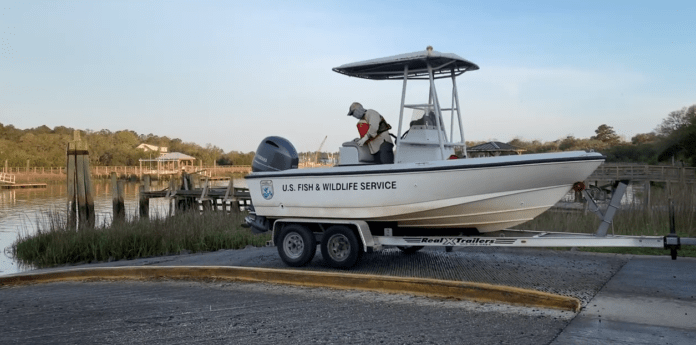ATLANTA, GA – The U.S. Fish and Wildlife Service today announced the addition of 446 acres to the Cape Romain National Wildlife Refuge near Charleston, a key acquisition that will boost wintering wetland habitat for migratory birds and recreational opportunities for bird lovers.
The South Carolina land purchase was approved earlier in the day by the Migratory Bird Conservation Commission (MBCC) chaired by Secretary of the Interior Deb Haaland.
Most of the $5 million to conserve the Cape Romain land came from the sale of Federal Migratory Bird Hunting and Conservation Stamps, commonly known as Duck Stamps. While waterfowl hunters must buy Duck Stamps as their annual license, wildlife enthusiasts of all kinds buy the stamps to help preserve wildlife habitats across the nation.
“As more and more people and businesses move to South Carolina, we must utilize every avenue to ensure our state’s precious natural resources are protected,” said S.C. Governor Henry McMaster. “Cape Romain’s expansion will protect our wildlife, safeguard our wetlands, and secure an additional slice of paradise for current and future generations of South Carolinians to enjoy.”
Cape Romain and the MBCC have quite a history of working together to help wildlife. The commission approved the refuge’s first acquisition in 1931, a year after Cape Romain was established. More than a third of the refuge’s nearly 72,000 acres was acquired with Migratory Bird Conservation Act, or Duck Stamp, funds.
Cape Romain covers about 10 percent of the South Carolina coastline and serves as critical wintering and breeding grounds for dozens of migratory shorebirds, including federally threatened species like red knots and piping plovers (which are listed as endangered in the Great Lakes region). The barrier islands, salt marshes, and tidal flats also provide winter homes for scaup, gadwalls, widgeons, teal, and ruddy ducks. Wood and mottled ducks breed there, too. The refuge also serves as critical habitat for loggerhead sea turtles, another threatened species.
The soon to be acquired, previously private land will add needed wetlands, managed impoundments, and forested uplands to Cape Romain. It should go a long way in helping the refuge achieve its management goal of 100,000 ducks. The public, too, should benefit from the expansion. Today, most of Cape Romain is only accessible by boat. The new land will offer direct vehicle access from the mainland.
“Cape Romain’s expansion is evidence of conservation funding in action,” said Mike Oetker, the Service’s acting Regional Director in the Southeast. “Paid for with Migratory Bird Conservation Commission funds, it really is a gift from the public to the public, and will be enjoyed by the community, hunters, anglers, wildlife enthusiasts, and photographers.”
In all, the MBCC on Wednesday approved $11.24 million in Duck Stamp (and some import fee) money to conserve 2,942 acres on wildlife refuges in South Carolina and Idaho. Since 1934, the Duck Stamp program has provided more than $1.2 billion for habitat conservation in the National Wildlife Refuge System. Duck Stamps also allow a free pass into any national wildlife refuge that charges an entry fee. Because nearly all the proceeds are used to conserve habitat, outdoor enthusiasts, including birders and nature photographers, buy Duck Stamps too.
The MBCC also on Wednesday approved $39.4 million in North American Wetlands Conservation Act (NAWCA) grants to help conserve or restore more than 106,000 acres of wetlands and uplands for waterfowl, shorebirds, and other birds across the United States. The money will be matched with $74.1 million in partner funds.
Since 1991, more than $2.1 billion in funds, matched by more than $4.3 billion in partner funds, have been approved by the commission, totaling $6.4 billion for wetland conservation.
“Cape Romain National Wildlife Refuge is synonymous with salt marsh — its miles of green and gold marsh have served as a sanctuary for wildlife and visiting humans alike for nearly a century,” said Robert Boyles, director of the South Carolina Department of Natural Resources. “This addition marks an exciting chapter beyond the salt marsh for the Refuge and for South Carolina, one that will offer the chance for visitors to connect with this special place without a boat for the first time. Hunters and wildlife enthusiasts across the country made this happen, and we’re fortunate to benefit from their stewardship ethic and the rich history of the Duck Stamp program.”
NAWCA is the only federal grant program dedicated to the conservation of wetland habitats for migratory birds. Since 1989, funding has advanced the conservation of wetland habitats and their wildlife in all 50 U.S. states, Canada and Mexico, while engaging more than 6,800 partners in over 3,300 projects. Through NAWCA, federal funds are typically leveraged at twice the legally required dollar-for-dollar non-federal match-to-grant ratio.
Partners in NAWCA projects include private landowners, state and local governments, Tribes, conservation organizations, sportsmen’s groups, land trusts and corporations. More information on these NAWCA grants is available on the Service’s web site.
This new NAWCA funding will benefit 12 ESA listed species, as well as 78 species listed as Birds of Conservation Concern, which helps prevent species from being listed. Today’s announcement comes as the highly effective ESA turns 50 years old in 2023. Throughout the year, the Department of the Interior will celebrate the ESA’s importance in preventing imperiled species extinction, promoting the recovery of wildlife, and conserving the habitats upon which they depend.
Additional information about North American wetlands and migratory bird conservation can be found on the Service’s Migratory Bird Program web page, where waterfowl enthusiasts, biologists and agency managers can find the most up-to-date waterfowl habitat and population information.
The U.S. Fish and Wildlife Service works with others to conserve, protect and enhance fish, wildlife, plants and their habitats for the continuing benefit of the American people. For more information, visit www.fws.gov, or connect with us through any of these social media channels: Facebook, Twitter, YouTube and Flickr.


